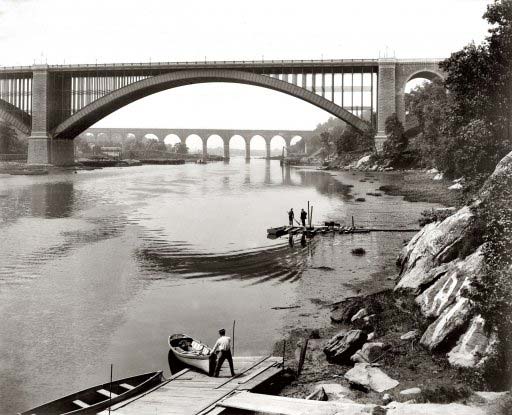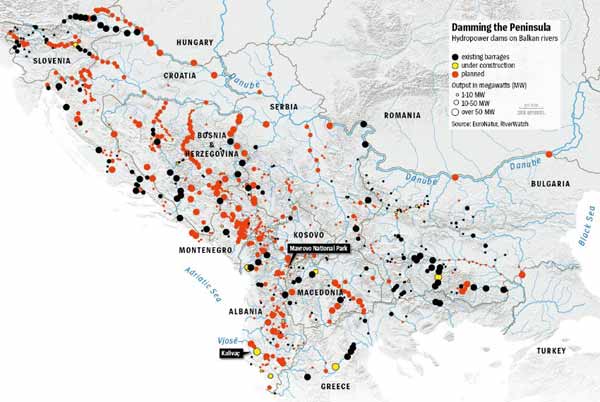
Claude Monet Boulevard des Capucines 1873

An appeal from Puerto Rico via Nicole:
Hurricane Maria destroyed many of Puerto Rico’s local seed and organic food-producing farm crops. Please, if you can, send me seeds. Even fruit seed for the tropics – I can plant them quickly. I will hand them out to those in need – as well as start flats in order to jumpstart their crops. Thank you!
Mara Nieves
PO BOX 9020931
Old San Juan, PR
00901-0931

Ready for more confrontation.
• Catalans Signal They May Declare Independence Within a Week (BBG)
Catalan separatist leaders signaled they may be moving toward a unilateral declaration of independence as early as this week after hundreds of activists were injured on Sunday as they sought to stop Spanish police from shutting down an illegal referendum. Catalan President Carles Puigdemont appealed to the European Union for support as he pledged to inform the regional parliament of the result of the vote in the coming days. The assembly will then act in line with the referendum law, Puigdemont said — and that could lead to a unilateral declaration of independence within 48 hours of the notification. “The citizens of Catalonia have won the right to have an independent state,” Puigdemont said in a televised statement, flanked by members of his regional administration.
Two million Catalans backed independence out of 2.3 million votes cast in total, government spokesman Jordi Turull said at a press conference in the early hours of Monday. Just over 5 million people were eligible to vote. Before the government crackdown began, separatist leaders said they would be comfortable declaring independence with about 1.8 million votes. Puigdemont’s time frame could see him announce the formation of a Catalan republic on Oct. 6, exactly 83 years since his predecessor as regional president, Lluis Companys, also declared independence. Companys was executed by the dictatorship of Francisco Franco. [..] Prime Minister Mariano Rajoy is wrestling with his country’s biggest constitutional crisis since Franco’s death in 1975 as Puigdemont looks to harness decades of frustration to force Catalonia out of Spain.
Heading a minority government, Rajoy is fighting to maintain his authority as allies peel off in the national parliament and his officials struggle to enforce the law in the rebel region. While a declaration of independence would have no legal force, and would most likely not be recognized by the international community, it would nevertheless constitute a historic challenge to the authority of the Spanish government and state institutions. On Sunday night, Rajoy praised police for their “calmness” in defending the constitutional order after they raided polling stations and seized ballot boxes in their efforts to shut down the vote. As forces deployed, camera phones beamed the confrontations to the world. In one video, broadcast by a local newspaper, a woman is seen being thrown down a flight of stairs.
In another, police rip ballot boxes from the hands of would-be electoral officials. “We’ve proved that our rule of law has the resources to repel an attack on democracy of this magnitude,” Rajoy said in a televised statement. “Look for no culprits other than those who organized an illegal act and have broken our common bonds. We’ve witnessed the type of behavior that would be repugnant for any democrat: the indoctrination of children, persecution of judges and journalists.”

Just weeks ago there wasn’t even a majority in the polls.
• Catalan Referendum Results Show 90% In Favour Of Independence (G.)
Catalan officials have claimed that preliminary results of its referendum have shown 90% in favour of independence in the vote vehemently opposed by Spain. Jordi Turull, the Catalan regional government spokesman, told reporters early on Monday morning that 90% of the 2.26 million Catalans who voted Sunday chose yes. He said nearly 8% of voters rejected independence and the rest of the ballots were blank or void. He said 15,000 votes were still being counted.The region has 5.3 million registered voters. Turull said the number of ballots did not include those confiscated by Spanish police during violent raids which resulted in hundreds of people being injured. At least 844 people and 33 police were reported to have been hurt, including at least two people who were thought to have been seriously injured.
Catalonia’s regional leader, Carles Puigdemont, spoke out against the violence with a pointed address: “On this day of hope and suffering, Catalonia’s citizens have earned the right to have an independent state in the form of a republic. “My government, in the next few days, will send the results of [the] vote to the Catalan parliament, where the sovereignty of our people lies, so that it can act in accordance with the law of the referendum.” Puigdemont had pressed ahead with the referendum despite opposition from the Spanish state, which declared the poll to be illegal, and the region’s own high court. He told crowds earlier in the day that the “police brutality will shame the Spanish state for ever”. The Spanish government defended its response after hundreds of people were hurt when riot police stormed polling stations in a last-minute effort to stop the vote on Sunday.

Background.
• Catalan Independence Referendum Is A Smokescreen For Other Issues (Ind.)
Tensions are running high in Catalonia, with riot police out in force and protesters advocating their right to vote being shot with rubber bullets. At the time of writing, more than 300 people have been injured and at least one person is currently undergoing surgery as a result of clashes between police and protesters. Police repression, the arresting of politicians and the intransigence of the Spanish government (“there will be no referendum” has been Prime Minister Mariano Rajoy’s favourite refrain over the last few weeks) make the temptation to simplify this into a simple left-right or good-bad discourse tantalising. But this issue is far from simple. Both sides in this debate are using the referendum to further their own political agendas.
Spain’s governing party, the Partido Popular (PP), is a right-wing party housing a spectrum of thought from neoliberalists to the hard-line right. The ruling party in Catalonia, PDeCAT, is a centre right party of the Catalan bourgeois which has historically been the natural ally of PP and not a traditional supporter of independence. Interestingly, their move to advocate a referendum has stopped their support from dropping in recent months. Alongside this, neither the national government nor the Catalan parliament are strangers to corruption in politics. PDeCAT has been plagued with allegations of corruption, debate around which has receded significantly as demands for independence have increased. PP, for its part, has often sought conflict as a means of garnering public support.
Positioning this referendum and the spectre of independence as a threat to Spanish citizens and their economic future – as well as tugging on the strings of nationalist patriotism in demanding the continued unity of Spain – PP has engaged widespread support. In recent days, Spanish flags have poured from windows and balconies, and in towns throughout Spain people have cheered the Civil Guard – Spain’s law enforcement agency which operates on military lines – with football chants advocating the defeat of the opposition. Against this political background, Spain is beginning to emerge from the crisis of which it has been in the grasp of since 2008. However, unemployment, particularly among young people, is still extremely high, with poverty and homelessness rates continuing to rise. Both Catalan and Spanish politicians have invoked nationalism as the banner beneath which popular support can be raised, allowing the referendum and its surrounding debates to create a vacuum in which these pressing social issues are demoted.

John Mauldin is a scary man.
• Global Retirement Reality: A $400 Trillion Shortfall (Mauldin)
I wrote a letter last June titled “Can You Afford to Reach 100?” Your answer may well be “Yes;” but, if so, you are one of the few. The World Economic Forum study I cited in that letter looked at six developed countries (the US, UK, Netherlands, Japan, Australia, and Canada) and two emerging markets (China and India) and found that by 2050 these countries will face a total savings shortfall of $400 trillion. That’s how much more is needed to ensure that future retirees will receive 70% of their working income. This staggering figure doesn’t even include most of Europe.
[..] The chart below shows the percentage of GDP needed to cover government pension payments in 2015 and 2050. But consider that the percentage of tax revenues required will be much higher. For instance, in Belgium the percentage of GDP going to pensions will be 18% in about 30 years, but that’s 40–50% of total tax revenues. That hunk doesn’t leave much for other budgetary items. Greece, Italy, Spain? Not far behind. And there is other research that makes the above numbers seem optimistic by comparison. The problem that the European economies have is that for the most part they are already massively in debt and have high tax rates. And they can’t print their own currencies. Many of Europe’s private pension companies and corporations are also in seriously deep kimchee. Low and negative interest rates have devastated the ability of pension funds to grow their assets.
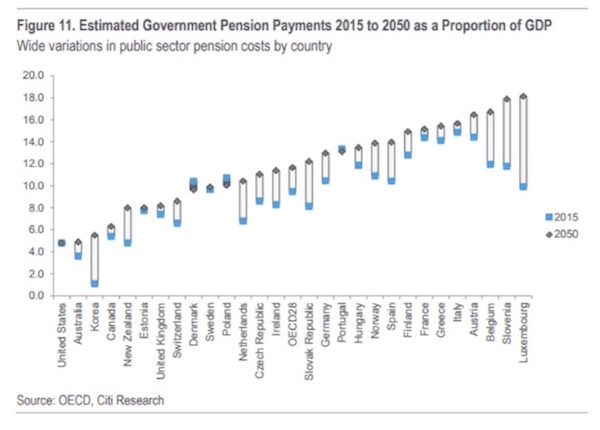
Combined with public pension liabilities, the total cost of meeting the income and healthcare needs of retirees is going to increase dramatically all across Europe. Macron, the new French president, really is trying to shake up the old order, to his credit; and this week he came out and began to lay the foundation for the mutualization of all European debt, which I assume would end up on the balance sheet of the ECB. However, that plan still doesn’t deal with the unfunded liabilities. Do countries just run up more debt? It seems like the plan is to kick the can down the road just a little further, something Europe is becoming really good at. In this next chart, note the line running through each of the countries, showing their debt as a percentage of GDP. Italy’s is already over 150%. And this is a chart based mostly on 2006 and earlier data. A newer chart would be much uglier.
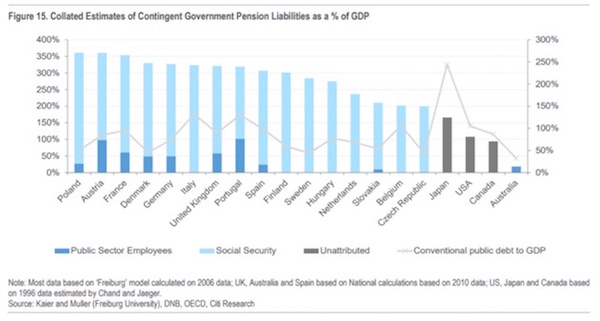
I could go on reviewing the retirement problems in other countries, but I hope you begin to see the big picture. This crisis isn’t purely a result of faulty politics – though that’s a big contributor – it’s a problem that is far bigger than even the most disciplined, future-focused governments and businesses can easily handle. Look what we’re trying to do. We think people can spend 35–40 years working and saving, then stop working and go on for another 20–30–40 years at the same comfort level – but with a growing percentage of retirees and a shrinking number of workers paying into the system. I’m sorry, but that’s magical thinking. And it’s not what the original retirement schemes envisioned at all. Their goal was to provide for a relatively small number of elderly people who were unable to work. Life expectancies were such that most workers would not reach that point, or would at least live just a few years beyond retirement.
As I have pointed out in past letters, when Franklin Roosevelt created Social Security for people over 65 years old, US life expectancy was about 56 years. If the retirement age had kept up with the increase in life expectancy, the retirement age in the US would now be 82. Try and sell that to voters. Worse, generations of politicians have convinced the public that not only is a magical outcome possible, it is guaranteed. Many politicians actually believe it themselves. They aren’t lying so much as just ignoring reality. They’ve made promises they aren’t able to keep and are letting others arrange their lives based on the assumption that the impossible will happen. It won’t.

“..betting on the VIX is a ‘quick way to lose money.'”
• Hedge Funds Are ‘Dancing On The Rim Of A Volcano’ (BI)
The market is calm. Perhaps too calm. The lack of price swings has investors mired in a sea of complacency, which has them ignoring potential risks, says Societe Generale. The firm specifically cites the CBOE Volatility Index – or VIX – which is used to track nervousness in the US stock market. Not only is the so-called fear gauge locked near the lowest levels on record, but hedge funds are betting it’ll decline even further. Their VIX positioning is the most bearish on record, according to data compiled by the US Commodity Futures Trading Commission. “Compare that with dancing on the rim of a volcano,” a group of SocGen strategists led by Alain Bokobza, the firm’s head of global asset allocation, wrote in a client note. “If there is a sudden eruption (of volatility) you get badly burned.”
This isn’t the first time SocGen has issued a warning about low volatility. Two weeks ago, the firm drew parallels to conditions leading up to the 2007 financial crisis. Describing the current situation as a “dangerous volatility regime,” the firm cited the strong mean-reverting tendency of price swings as a big reason why investors should be bracing themselves. Other heavyweights in the investment field have also spoken out about the low-price-swing situation that they see as untenable. In late July, JPMorgan global head of quantitative and derivatives strategy Marko Kolanovic compared rock-bottom volatility to the conditions leading up to the 1987 stock market crash. [..] Laszlo Birinyi, the investment guru who predicted the bull market and has been repeatedly correct over its 8 1/2-year run, said that betting on the VIX is a “quick way to lose money.”
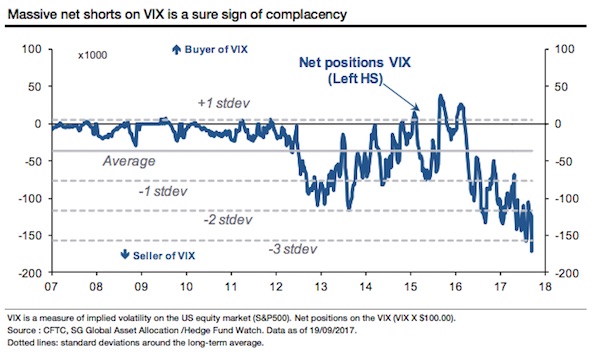

“..the large banks cannot survive without cheating customers, creditors and shareholders..”
• CDO Redux: Credit Spreads & Financial Fraud (Whalen)
The moral of the story with Citi and other large banks is that there is no free lunch, but sadly no one on the FOMC seems to appreciate this subtlety. When the Fed pushes down interest rates and then manipulates credit spreads to achieve some illusory goal in terms of monetary policy, the result is a change in the behavior of investors and lenders that is profound. The fact that Citi, JPM and GS are now pushing back into the dangerous world of off-balance sheet (OBS) derivatives just illustrates the fact that the large banks cannot survive without cheating customers, creditors and shareholders. And just as retailers cannot compete with AMZN, Citi and GS certainly cannot compete against the monopoly power of the House of Morgan. In the case both of Citi and JPM, just half of the banks’ operating business comes from lending, while the remainder comes from risk bearing investments and trading.
With some $50 trillion in off-balance sheet (OBS) derivatives, which is almost six standard deviations above the $1.8 trillion peer average for large banks, Citi and JPM are now the outliers on Wall Street in terms of derivatives exposure. A move of 30bp in the OBS derivatives book of either bank would wipe out their capital. Chart One below shows the OBS derivatives exposure of Citi, JPM, GS and the other major banks. Notice that all three of the leading derivatives dealers have been increasing exposures since last year. Note too that the relatively small GS has a notional OBS derivatives book of more than $41 trillion, almost as large as that of Citi and JPM. More alarming, a move of just 7bp in the smaller bank’s OBS derivatives exposures would wipe out the capital of Goldman’s subsidiary bank. This gives GS an effective leverage ratio vs its notional OBS derivatives exposures of 8,800 to 1.
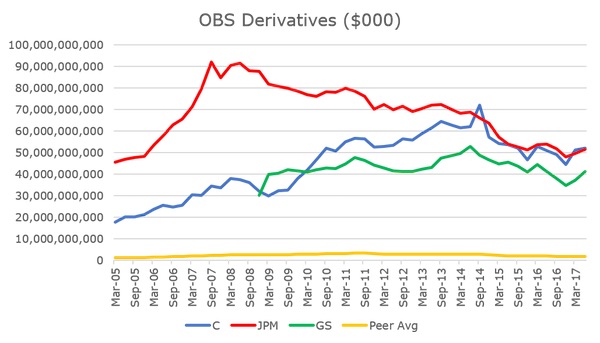

Yesterday it was the HuffPo, now Bloomberg. Blaming Trump unfairly is a bad approach. Exit echo chamber.
• No, Trump Didn’t Botch the Puerto Rico Crisis (BBG)
[..] to look at the larger context of the entire relief operation, I decided to talk to someone whose experience rivals that of General Honore: retired Navy Captain Jerry Hendrix. Now a senior fellow with the Center for a New American Security, Hendrix served for decades both on the high seas and in high-level staff jobs, including with the Chief of Naval Operations’ Executive Panel and the Office of the Undersecretary of Defense for Policy’s Irregular Warfare Quadrennial Defense Review. Few people know more about military history than Hendrix, who has degrees from Purdue, Harvard, the Naval Postgraduate School and a Ph.D. from Kings College in London. Little wonder that in 2012 was named the service’s director of naval history.
TH: So, it seems like everybody has blasted Trump administration’s response to the Puerto Rico crisis. Has that criticism been fair?
JH: No, I don’t think so. First of all, there was a fair amount of anticipatory action that is not being recognized. Amphibious ships including the light amphibious carriers Kearsarge and Wasp and the amphibious landing ship dock Oak Hill were at sea and dispatched to Puerto Rico ahead of the hurricane’s impact. These are large ships that have large flight decks to land and dispatch heavy-lift CH-53 helicopters to and from disaster sites. They also have big well-decks – exposed surfaces that are lower than the fore and aft of the ship – from which large landing craft can be dispatched to shore carrying over 150 tons of water, food and other supplies on each trip. These are actually the ideal platforms for relief operations owing to their range of assets. The ships, due to their designs to support Marine amphibious landings in war zones, also have hospitals onboard to provide medical treatment on a large scale. That these ships were in the area should be viewed as a huge positive for the administration and the Department of Defense.
TH: Your plaudits toward the White House on all this are surprising to say the least. But where does the response still need to improve?
JH: One area in which the Trump administration could possibly lend additional assistance would be looking at a more robust activation of its assets in the Defense Department’s Transportation Command to include more heavy-lift and cargo aircraft, as well as Maritime Administration shipping to move the logistics-heavy large infrastructure items on the ocean. Everything from bulldozers to transformers needs to come by ships, and it’s been decades since it was really flexed to its full capacity. This would have the dual purpose of revealing any significant weaknesses in the Transportation Command assets and readiness should we need it in a military emergency down the road.

Does this mean everybody gets what they want?
• Trump Urges Staff To Portray Him As “Crazy Guy” (Axios)
In an Oval Office meeting earlier this month, President Trump gave his top trade negotiator, Robert Lighthizer, an Art of the Deal-style coaching session on how to negotiate with the South Koreans. Trump’s impromptu coaching came in the middle of a pivotal conversation with top officials about whether or not to withdraw from the U.S.-Korean trade deal. Sources familiar with the conversation recounted the exchange for Axios, and the White House did not dispute this account. A number of senior officials and cabinet secretaries were present for the conversation, including Defense Secretary Mattis, Agriculture Secretary Perdue, and Secretary of State Tillerson. At issue was whether the U.S. would withdraw from the Korean trade deal — an action Trump threatened but still hasn’t done.
“You’ve got 30 days, and if you don’t get concessions then I’m pulling out,” Trump told Lighthizer. “Ok, well I’ll tell the Koreans they’ve got 30 days,” Lighthizer replied. “No, no, no,” Trump interjected. “That’s not how you negotiate. You don’t tell them they’ve got 30 days. You tell them, ‘This guy’s so crazy he could pull out any minute.'” “That’s what you tell them: Any minute,” Trump continued. “And by the way, I might. You guys all need to know I might. You don’t tell them 30 days. If they take 30 days they’ll stretch this out.” Why this matters: Plenty of world leaders think the president is crazy — and he seems to view that madman reputation as an asset. The downsides are obvious: the rhetoric can unnerve allies and has the potential to provoke enemies into needless, unintended war. But Trump keeps using the tactic, with varying degrees of success:
Just today, the president undercut his secretary of state by suggesting diplomacy with “Little Rocket Man” in North Korea was a waste of time — implying that only military action would resolve the conflict. “Save your energy Rex,” Trump tweeted, “we’ll do what has to be done!” We’ve never seen anything like this before. Trump’s tweet, undercutting Tillerson’s diplomatic efforts, comes a day after Tillerson acknowledged for the first time that the administration was in direct communication with North Korea. Trump’s tweet also undercuts a statement made Tuesday by Joint Chiefs Chairman General Dunford: “The military dimension today is in full support of the economic and diplomatic pressure campaign the secretary of state is leading in North Korea.”

The kind of thing that can lead to war.
• Egypt Fears Disaster From Largest Hydroelectric Dam In Africa (AP)
The only reason Egypt has even existed from ancient times until today is because of the Nile River, which provides a thin, richly fertile stretch of green through the desert. For the first time, the country fears a potential threat to that lifeline, and it seems to have no idea what to do about it. Ethiopia is finalizing construction of the Grand Ethiopian Renaissance Dam, its first major dam on the Blue Nile, and then will eventually start filling the giant reservoir behind it to power the largest hydroelectric dam in Africa. Egypt fears that will cut into its water supply, destroying parts of its precious farmland, hampering its large desert reclamation projects and squeezing its bourgeoning population of 93 million people, who already face water shortages. Dam construction on international rivers often causes disputes over the downstream impact.
But the Nile is different: few nations rely so completely on a single river as much as Egypt does. The Nile provides over 90% of Egypt’s water supply. Almost the entire population lives cramped in the sliver of the Nile Valley. Around 60% of Egypt’s Nile water originates in Ethiopia from the Blue Nile, one of two main tributaries. Egypt barely gets by with the water it does have. Because of its population, it has one of the lowest per capita shares of water in the world, some 660 cubic meters a person. The strain is further worsened by widespread inefficiency and waste. With the population on a path to double in 50 years, shortages are predicted to become severe even sooner, by 2025. That is despite the fact that Egypt already receives the lion’s share of Nile waters: more than 55 billion of the around 88 billion cubic meters of water that flow down the river each year.
It is promised that amount under agreements from 1929 and 1959 that other Nile nations say are unfair and ignore the needs of their own large populations. Complicating the issue, no one has a clear idea what impact Ethiopia’s dam will actually have. Addis Ababa says it will not cause significant harm to Egypt or Sudan downstream. Much depends on management of the flow and how fast Ethiopia fills its reservoir, which can hold 74 billion cubic meters of water. A faster fill means blocking more water at once, while doing it slowly would mean less reduction downstream.[..] One study by a Cairo University agriculture professor estimated Egypt would lose a staggering 51% of its farmland if the fill is done in three years. A somewhat slower fill over six years would cost Egypt 17% of its cultivated land, the study claimed

“..its 83 islands are stuck right in the middle of hurricane alley and they dot the border of the “ring of fire”..”
• Planes, Ships, Barges: The DIY Evacuation Of Vanuatu’s Volcano Island (G.)
Vanuatu is no stranger to the rumblings, shakings, flood waters and wrecking winds of natural disaster. The south Pacific island nation was rated the most at-risk country in the world in a 2016 United Nations study. Its 83 islands are stuck right in the middle of hurricane alley and they dot the border of the “ring of fire” – a belt around the Pacific prone to earthquakes and volcanic eruptions. Despite their precarious situation being a day-to-day reality, the country has been galvanised by the prime minister Charlot Salwai’s order to evacuate the entire island of Ambae because of the threat that the volcano at its centre will blow. “People’s lives must be our first priority,” Salwai said. “Everybody has to go.” What followed has been Vanuatu’s own version of the Dunkirk evacuation. Folk began organising even before Salwai gave the order.
The Ni-Vanuatu – the people of this archipelago – are defined by two things: land and family. From the moment a state of emergency was announced, members of the Ambae community in Port Vila, the capital, began to mobilise. They knew better than to wait for the cash-strapped, resource-starved government and instead jury-rigged a disaster response centre at a church. Local companies began donating goods immediately. Before long they had stockpiles of water, food, bedding and other essentials ready to send. Then they chartered a ship. The MV Makila was one of the first of Vanuatu’s ragtag fleet of inter-island barges and coasters to reach Ambae with supplies. It unloaded those goods then took more than 100 passengers to safety on the nearby island of Espiritu Santo. Then it went back and did it again.
There was no hesitation, no reflection. The ships had to run. So the community members dug deep and shifted for themselves. [..] Nadia Kanegai has been a personal assistant to a prime minister, and a former political candidate herself. A past master at getting things done by Vanuatu’s often shambolic bureaucracy, she didn’t flinch at the difficulties presented by moving hundreds of her home island’s most vulnerable inhabitants to safety. She just hired a plane and told the pilot to keep flying until everyone was out. Kanegai won’t discuss how much this airlift is costing her, but whistle-stop charter flights to the outer islands typically cost the equivalent of £1,000 for a return hop. Her plane made 18 flights on the first day alone.

Bloomberg headline “Why Russia Should Love Climate Change Deniers”. Because that sells better than Mongolia?
• Climate Change Will Make Some Countries Richer – IMF (BBG)
President Donald Trump and other climate-change deniers probably don’t think of themselves as contributing to Russia’s future prosperity. But judging from a new International Monetary Fund report, that’s what they might be doing. In its latest World Economic Outlook, the IMF offers a sobering analysis of global warming’s potential repercussions. Looking at the historical relationship between climate and economic output, it finds that poor countries in hot regions – home to a majority of the world’s population – are likely to suffer the most as average temperatures rise. Here’s a map showing the effect of a one-degree-Celsius temperature increase on per-capita GDP, with countries scaled to reflect their populations:
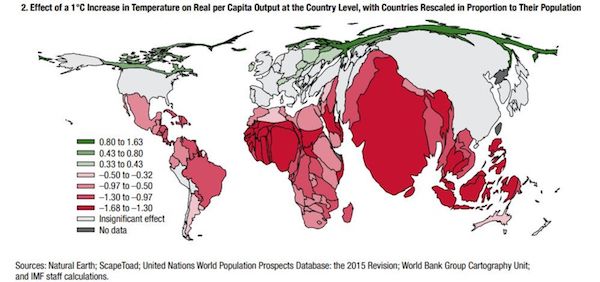
Gazing at the map, though, I couldn’t help but ask: What about the winners? Those green areas in the north certainly suggest that somebody stands to gain. So I downloaded the data to see which countries would get a per-capita GDP boost. Mongolia, Iceland, Finland and Russia topped the IMF’s list. Here’s the whole thing:
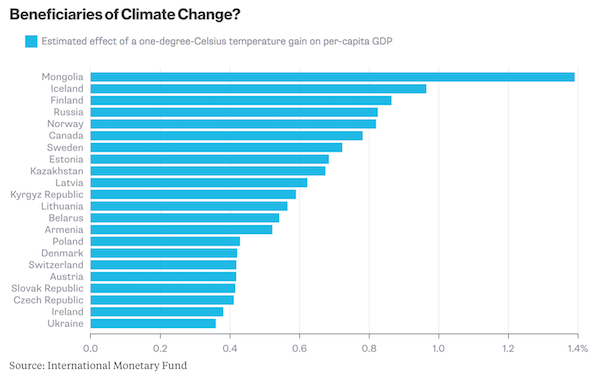
To be sure, this doesn’t mean that the countries will turn into a tropical paradises. For one, the researchers derived their estimates from the relatively small weather fluctuations of the past – nobody can really know what will happen if temperatures go beyond what humans have experienced. Also, don’t forget bigger natural disasters, forced migrations and all the other ills that climate change is expected to bring. That said, the data do suggest that Russia could, at least initially, be an unintended beneficiary of what amounts to a global injustice of epic proportions. Look again at that map: The poor countries in the south stand to bear the brunt of a catastrophe created largely by the wealthy countries in the middle, while the countries in the north get a windfall. That’s an outcome to which Trump, by downplaying the dangers of global warming and withdrawing from the Paris climate accord, has already made a significant contribution.


